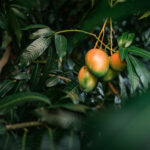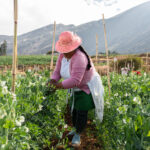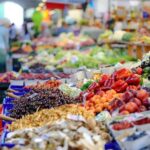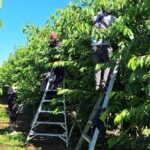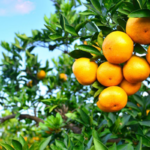As mango demand grows in the U.S., growers increase volumes

Both the supply and consumption of mango in the U.S. have experienced a steady increase in the last few years, prompting exporters from Central and South America to increase their production volumes.
Exporters, along with U.S. importers and associations, have campaigned to promote the nutritional values and health benefits of the fruit, aiming to increase per-capita consumption.
FreshFruitPortal.com spoke with Leonardo Ortega, Director of Research at the National Mango Board, to learn about the challenges, strengths, projections, and opportunities for the U.S. mango industry.
The director shared an analysis of production areas, markets, varieties, commercialization, and sustainability of the industry.
Ortega said that 99% of mangos consumed in the U.S. are imported since local production in Florida and California is low.
According to data from the National Mango Board, from its foundation in 2005 to 2022, the volume of the fruit has more than doubled from 62 million 4kg boxes to approximately 139 million boxes.
And in terms of consumption, it has gone from 1,88 pounds per person/year to 3,7 pounds per person/year.
"It is a considerable increase and our vision is that consumption will continue to grow in the United States as it is doing and, if possible, at a much higher rate," Ortega said.
Q&A: Exporters in the market
How do you see the mango industry, is there anything that has surprised you in terms of performance?
The Mexican market has grown a lot and they have greatly increased their exports; last year they hit a record in export volumes.
Another country that has increased its production is Peru, this year I am almost sure they will have a great year, they are already reaching 20 million boxes and maybe they will surpass it. For Peru, more than 20 million boxes would be a record.
In general terms, 98% of the volume consumed here is exported by six countries.
Mexico is the main exporter with 65% of the volume, followed by Peru, Ecuador, and Brazil, which have between 12% and 15%.
Then comes Guatemala with 3.5% - 4 million boxes per year -, followed by Haiti and the Dominican Republic, which account for around 2 million boxes.
The Dominican Republic started exporting mangoes two to three years ago to the U.S. and the Mingolo variety they are sending has been successful.
What do you think Mexico has done to export 65% of the volume that reaches the U.S.?
Well, the main thing is the proximity to the U.S. Mexico has the great advantage of being a neighboring country, its production costs are lower, and its transportation costs are also lower in relation to other exporters.
In addition, the Association of Packers and Mango Producers (EMEX), has done an excellent job to promote the production and export of mangoes.
The Sinaloa Association, which is in a free zone where the volume of production has grown a lot in recent years, has also done a very good job.
Aspro Mango, which works with mango production has also been important for the growth of the industry.
Based on your experience, which is the most popular mango variety?
It's a difficult question to answer because it comes down to personal preference. However, the variety with the highest volume in the U.S. is the Tomiaki mango, followed by the Ataúlfo and the Kent mango; there are other varieties such as Keitt and Haden as well.
There are also varieties from Haiti such as Francique, and Mingolo from the Dominican Republic, already at around 2 million boxes per year.
How could you summarize the research work you are doing and the challenges for 2023?
Our research programs are in nutrition and health. The program was created in order to investigate the phytochemical compounds and the nutritional value of the varieties consumed in the U.S., as mentioned above. The purpose is to investigate their nutritional value, to see if those compounds are related to health and the different diseases that exist here.
For this year we have approved almost six new projects out of a total of 14, all of which have to do with the impact of mangoes on human health: cardiovascular health, diabetes, obesity, skin health, and gastrointestinal health.
The projects are a joint work between universities and industry members, funded by the National Mango Board. Every year we put out a request for research proposals and we define the areas and sometimes the population areas we want the studies to focus on.
In the last two to three years the focus has been on young people, children, and pregnant or lactating women to see the benefits that mangos have in all these health areas, especially here in the U.S. where it is very much needed.
We also do research in other areas such as production, post-harvest, sustainability and safety. However, in nutrition and health, which is our main area, we establish a strategic plan, which is reviewed every three to five years, where we define the areas of research and the population on which we want to focus our research.
What shortcomings do you observe in mango producers and how can they adopt technologies in their processes?
We work very closely with producer and exporter associations, in order to know how the mango industry is in each country, and how they are evolving and growing in production areas.
The technology is already commercial, what we are trying to fine-tune are the best practices to use the technology and make sure that the mango has a good life and maintains its quality during transportation.
Within the industry relations programs, we have extension workshops.
We go to the main mango exporting countries, such as Mexico, Guatemala, Ecuador, Peru, Brazil, Haiti, and the Dominican Republic, to transfer the knowledge and information generated by the different studies, and we bring them closer to the researchers to explain different techniques so they can solve their problems.
How do you see the mango industry five years from now?
I am an agricultural economist so I rely heavily on data. The volume of imports has increased more than 100%, and we have already doubled per capita consumption in the United States.
If we are now at 3,7 pounds per person/year, our goal is to double to 7 pounds of mango consumption here in the U.S. in the next three to five years. This is a very achievable goal.
Versatility is a very important factor in marketing programs, there is one called "Series of origins", where we show the productions in Hawaii, Mexico, and Puerto Rico, etc. where we show the importance of the mango industry from the point of view of employment, work, all the social part that involves the industry and packing houses.

















